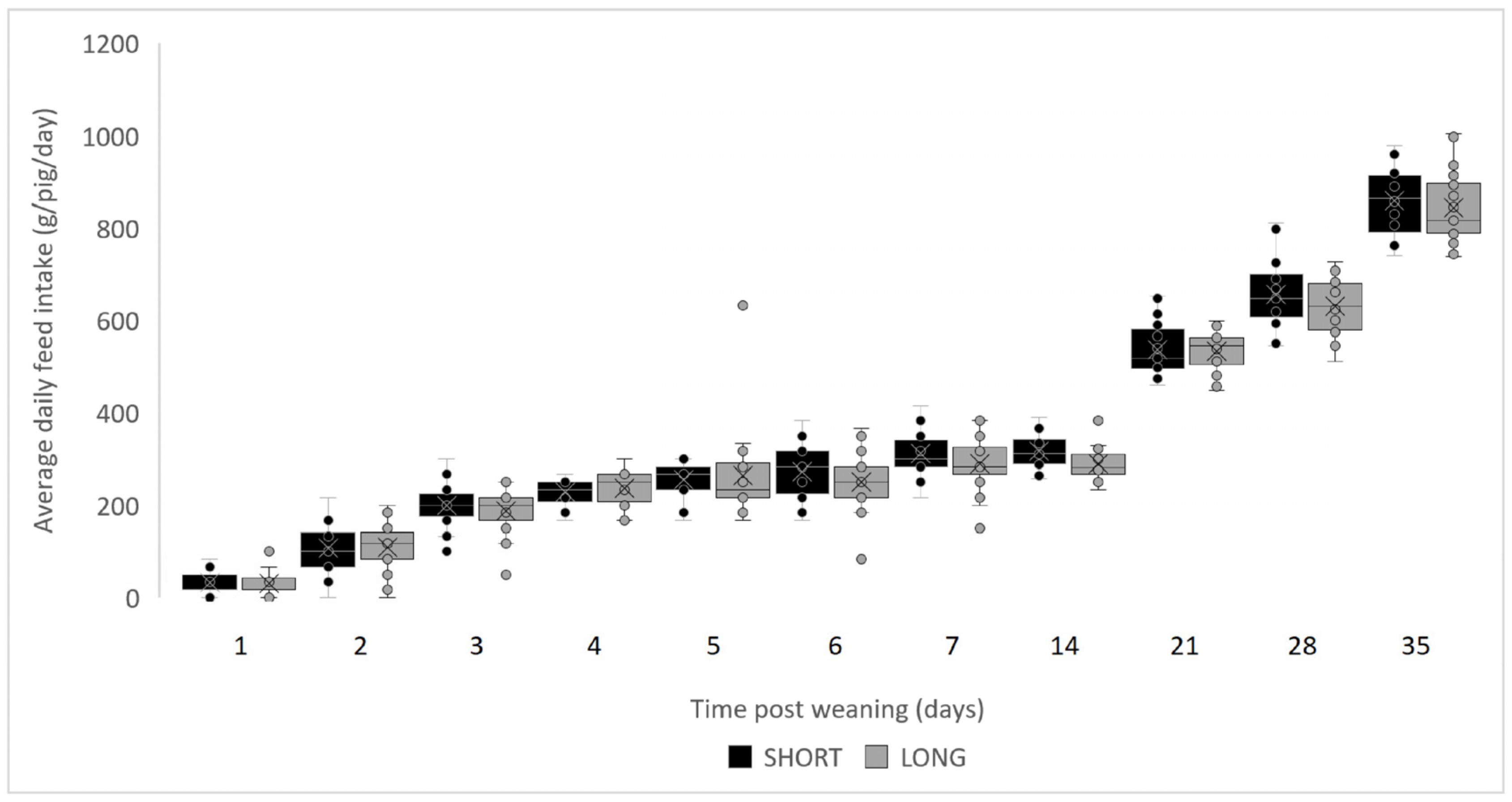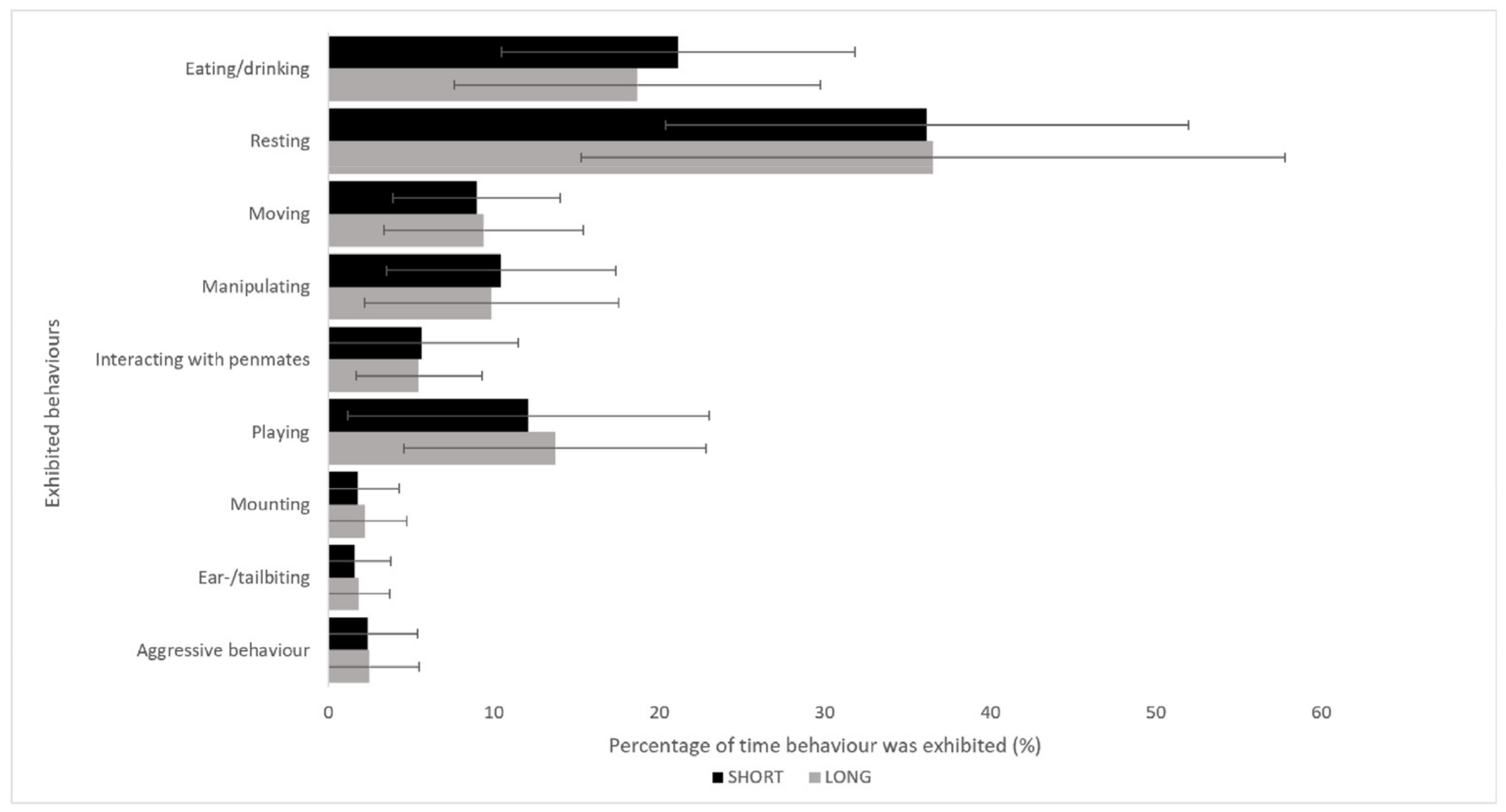Effect of Extended Photoperiod on Performance, Health, and Behavioural Parameters in Nursery Pigs
Abstract
Simple Summary
Abstract
1. Introduction
2. Materials and Methods
2.1. Animals and Location
2.2. Lighting
2.3. Ventilation, Nutrition, and Management
2.4. Performance Parameters
2.5. Faecal Consistency
2.6. Animal Behaviour and Welfare
- Tail biting (0: no lesions, 4: tail completely chewed off, or recovered),
- Ear biting (0: no lesions, 4: most of the ear has been bitten off or severe bitemarks on both ear),
- Skin lesions (0: no lesions, 5: multiple lesions on multiple body parts),
- Abdominal distension (0: empty abdomen, 1: distended abdomen).
2.7. Statistical Analysis
3. Results
3.1. Performance Parameters
3.2. Faecal Consistency
3.3. Animal Behaviour and Welfare
4. Discussion
5. Conclusions
Author Contributions
Funding
Institutional Review Board Statement
Informed Consent Statement
Data Availability Statement
Acknowledgments
Conflicts of Interest
References
- Le Dividich, J.; Herpin, P. Effects of climatic conditions on the performance, metabolism and health status of weaned piglets: A review. Livest. Sci. 1994, 38, 79–90. [Google Scholar] [CrossRef]
- Dong, G.Z.; Pluske, J.R. The low feed intake of newly-weaned pigs: Problems and possible solutions. Asian-Australas. J. Anim. Sci. 2007, 20, 440–452. [Google Scholar] [CrossRef]
- Jayaraman, B.; Nyachoti, C.M. Husbandry practices and gut health outcomes in weaned piglets: A review. Anim. Nutr. 2017, 3, 205–211. [Google Scholar] [CrossRef] [PubMed]
- Bruininx, E.M.A.M.; van der Peet-Schwering, C.M.C. Voederopname van gespeende biggen: Effecten van speengewicht en lichtschema. Prakt. Varkenshoud. 1999, 13, 18–20. [Google Scholar]
- Bruininx, E.M.A.M.; van der Peet-Schwering, C.M.C.; Schrama, J.W.; Vereijken, P.F.G.; Vesseur, P.C.; Everts, H.; den Hartog, L.A.; Beynen, A.C. Individually measured feed intake characteristics and growth performance of group-housed weanling pigs: Effects of sex, initial body weight, and body weight distribution within groups. J. Anim. Sci. 2001, 79, 301–308. [Google Scholar] [CrossRef]
- Bruininx, E.M.A.M.; Heetkamp, M.J.W.; van den Bogaart, D.; Van der Peet-Schwering, C.M.C.; Beynen, A.C.; Everts, H.; den Hartog, L.A.; Schrama, J.W. A prolonged photoperiod improves feed intake and energy metabolism of weanling pigs. J. Anim. Sci. 2002, 80, 1736–1745. [Google Scholar] [CrossRef]
- Niekamp, S.R.; Sutherland, M.A.; Dahl, G.E.; Salak-Johnson, J.L. Immune reponses of piglets to weaning stress: Impacts of photoperiod. J. Anim. Sci. 2007, 85, 93–100. [Google Scholar] [CrossRef]
- Kluiver-Poodt, M.; Binnendijk, G.; Houthuijs, M. Effect van Ledverlichting op Dragende Zeugen en Gespeende Biggen, Wageningen University and Research (WUR): Wageningen, The Netherlands. 2018. Available online: https://library.wur.nl/WebQuery/wurpubs/fulltext/461164 (accessed on 25 December 2022).
- Glatz, P.C. Effect of different lighting sources on behaviour and growth of weanling pigs. Asian-Australas. J. Anim. Sci. 2001, 14, 280–287. [Google Scholar] [CrossRef]
- Gomes, L.M.; Miassi, G.M.; dos Santos, L.S.; Saleh, M.A.D.; Sartori, J.R.; Tse, M.L.P.; Berto, D.A. Impact of two light programs and two levels of dietary tryptophan for weanling piglets. Livest. Sci. 2018, 216, 191–196. [Google Scholar] [CrossRef]
- Moinard, C.; Mendi, M.; Nicol, C.J.; Green, L.E. A case control study of on-farm risk factors for tail biting in pigs. Appl. Anim. Behav. Sci. 2003, 81, 333–355. [Google Scholar] [CrossRef]
- Allwin, B.; Gokarn, N.S.; Vedamanickam, S.; Gopal, S. The wild pig (Sus scrofa) behavior—A retrospective study. J. Dairy Vet. Anim. Res. 2016, 3, 115–125. [Google Scholar] [CrossRef]
- Ingram, D.L.; Dauncey, M.J. Circadian rhythms in the pig. Comp. Biochem. Physiol. 1985, 82, 1–5. [Google Scholar] [CrossRef]
- Frädrich, H. The Behavior of Ungulates and It’s Relation to Management: A Comparison of Behavior in the Suidae; IUCN Publications New Series: University of Calgary, Alberta, Canada, 1971; Volume 24, pp. 133–142. Available online: https://portals.iucn.org/library/efiles/documents/ns-024-2.pdf (accessed on 25 December 2022).
- Špinka, M. Behaviour of pigs. In The Etiology of Domestic Animals, an Introductory Text, 3rd ed.; Jensen, P., Ed.; CABI: New York, NY, USA, 2017; pp. 214–227. [Google Scholar] [CrossRef]
- Weiler, U.; Claus, R.; Dehnhard, M.; Hofäcker, S. Influence of photoperiod and a light reverse program on metabolically active hormones and food intake in domestic pigs compared with a wild boar. Can. J. Anim. Sci. 1996, 76, 531–539. [Google Scholar] [CrossRef]
- Prunier, A.; Dourmad, J.Y.; Etienne, M. Effect of light regimen under various ambient temperatures on sow and litter performance. J. Anim. Sci. 1994, 72, 1461–1466. [Google Scholar] [CrossRef]
- Auvigne, V.; Leneveu, P.; Jehannin, C.; Peltoniemi, O.; Sallé, E. Seasonal infertility in sows: A five year field study to analyze the relative roles of heat stress and photoperiod. Theriogenology 2010, 74, 60–66. [Google Scholar] [CrossRef]
- Lewis, C.R.G.; Bunter, K.L. Effects of seasonality and ambient temperature on genetic parameters for production and reproductive traits in pigs. Anim. Prod. Sci. 2011, 51, 615–626. [Google Scholar] [CrossRef]
- De Rensis, F.; Ziecik, A.J.; Kirkwood, R.N. Seasonal infertility in gilts and sows: Aetiology, clinical implications and treatments. Theriogenology 2017, 96, 111–117. [Google Scholar] [CrossRef]
- European Commission Directive. Amending Directive 91/630/EC Laying Down Minimum Standards for the Protection of Pigs. 2003/93/EC. Available online: https://eur-lex.europa.eu/LexUriServ/LexUriServ.do?uri=OJ:L:2001:316:0036:0038:NL:PDF (accessed on 25 December 2022).
- Dahl, G.E.; Elsasser, G.E.; Capuco, A.V.; Erdman, R.A. Peters RR. Effects of a long daily photoperiod on milk yield and circulating concentrations of insulin-like growth factor-I. J. Dairy Sci. 1997, 80, 2784–2789. [Google Scholar] [CrossRef]
- Velasco, J.M.; Fried, E.D.; Gressley, T.F.; Wallace, R.L.; Dahl, G.E. Short-day photoperiod increases milk yield in cows with a reduced dry period length. J. Dairy Sci. 2008, 91, 3467–3473. [Google Scholar] [CrossRef]
- Lewis, P.D.; Danisman, R.; Gous, R.M. Photoperiodic reponses of broilers. I. Growth, feeding behaviour, breast meat yield, and testicular growth. Br. Poult. Sci. 2009, 50, 657–666. [Google Scholar] [CrossRef]
- Olanrewaju, H.A.; Thaxton, J.P.; Dozier III, W.A.; Purswell, J.; Roush, W.B.; Branton, S.L. A review of lighting programs for broiler production. Int. J. Poult. Sci. 2006, 5, 301–308. [Google Scholar] [CrossRef]
- European Council Directive. Laying down Minimum Standards for the Protection of Pigs. 2008/120/EC. Available online: https://eur-lex.europa.eu/legal-content/EN/TXT/PDF/?uri=CELEX:32016H0336 (accessed on 22 January 2023).
- European Commission Recommendation. On the Application of Council Directive 2008/120/EC Laying down Minimum Standards for the Protection of Pigs as Regards Measures to Reduce the Need for Tail-Docking. 2016/336. Available online: https://eur-lex.europa.eu/legal-content/EN/TXT/PDF/?uri=CELEX:32016H0336 (accessed on 22 January 2023).
- Bates, D.; Kliegl, R.; Vasishth, S.; Baayen, H. Parsimonious Mixed Models; Cornell University: New York, NY, USA, 2011; Available online: https://arxiv.org/abs/1506.04967 (accessed on 22 January 2023).
- Lay, D.C.; Buchanan, H.S.; Haussmann, M.F. A note on stimulating the ‘observer effect’ using constant photoperiod on nursery pigs. Appl. Anim. Behav. Sci. 1999, 63, 301–309. [Google Scholar] [CrossRef]
- Nielsen, B.L.; Lawrence, A.B.; Whittemore, C.T. Effect of group size on feeding behaviour, social behaviour, and performance of growing pigs using single-space feeders. Livest. Prod. Sci. 1995, 44, 73–85. [Google Scholar] [CrossRef]
- Barszcz, M.; Skomial, J. The development of the small intestine of piglets–chosen aspects. J. Anim. Feed Sci. 2011, 20, 3–15. [Google Scholar] [CrossRef]





| Parameter | SHORT Mean ± SD | LONG Mean ± SD | Df | F-Value | p-Value |
|---|---|---|---|---|---|
| BWstart (kg) | 8.1 ± 1.10 | 8.1 ± 1.15 | 1 | NA | 0.743 |
| BWend (kg) | 22.19 ± 1.63 | 21.59 ± 1.37 | 1 | 3.63 | 0.064 |
| ADFI (kg) | 0.510 ± 0.041 | 0.496 ± 0.036 | 1 | 2.31 | 0.136 |
| FCR (kg/kg) | 1.26 ± 0.090 | 1.29 ± 0.057 | 1 | 1.66 | 0.204 |
| ADG (kg) | 0.403 ± 0.082 | 0.385 ± 0.079 | 1 | 3.63 | 0.063 |
Disclaimer/Publisher’s Note: The statements, opinions and data contained in all publications are solely those of the individual author(s) and contributor(s) and not of MDPI and/or the editor(s). MDPI and/or the editor(s) disclaim responsibility for any injury to people or property resulting from any ideas, methods, instructions or products referred to in the content. |
© 2023 by the authors. Licensee MDPI, Basel, Switzerland. This article is an open access article distributed under the terms and conditions of the Creative Commons Attribution (CC BY) license (https://creativecommons.org/licenses/by/4.0/).
Share and Cite
Griffioen, F.; Aluwé, M.; Maes, D. Effect of Extended Photoperiod on Performance, Health, and Behavioural Parameters in Nursery Pigs. Vet. Sci. 2023, 10, 137. https://doi.org/10.3390/vetsci10020137
Griffioen F, Aluwé M, Maes D. Effect of Extended Photoperiod on Performance, Health, and Behavioural Parameters in Nursery Pigs. Veterinary Sciences. 2023; 10(2):137. https://doi.org/10.3390/vetsci10020137
Chicago/Turabian StyleGriffioen, Friso, Marijke Aluwé, and Dominiek Maes. 2023. "Effect of Extended Photoperiod on Performance, Health, and Behavioural Parameters in Nursery Pigs" Veterinary Sciences 10, no. 2: 137. https://doi.org/10.3390/vetsci10020137
APA StyleGriffioen, F., Aluwé, M., & Maes, D. (2023). Effect of Extended Photoperiod on Performance, Health, and Behavioural Parameters in Nursery Pigs. Veterinary Sciences, 10(2), 137. https://doi.org/10.3390/vetsci10020137







